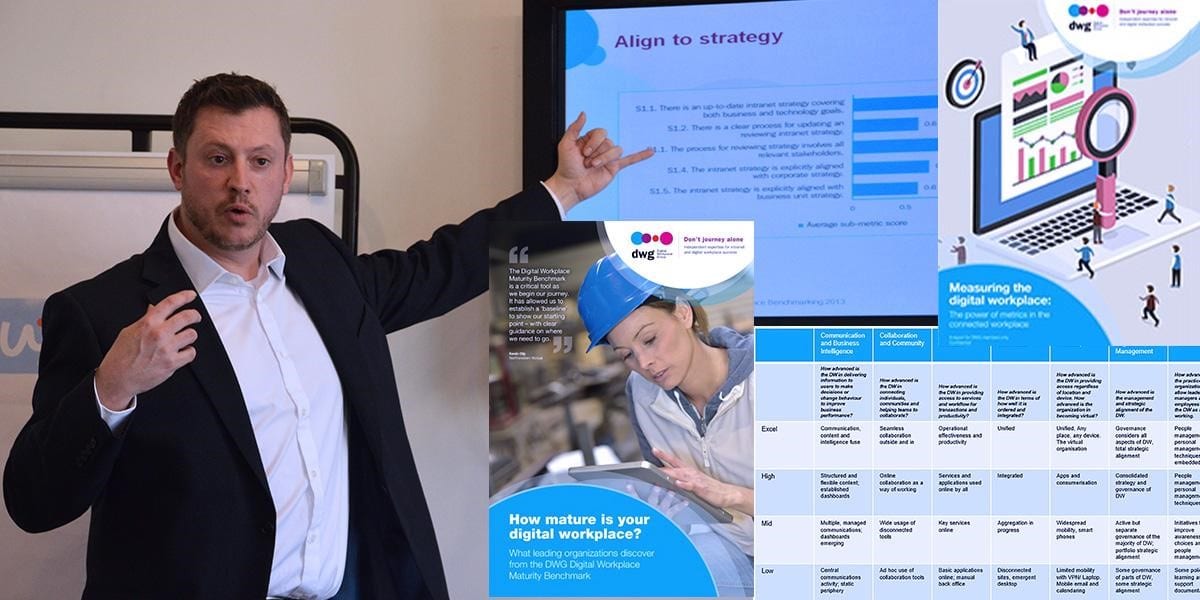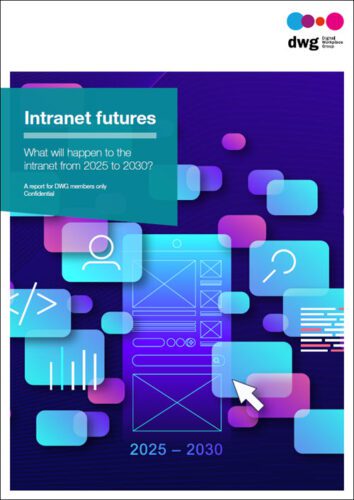Digital Workplace Maturity Benchmark Insights

We have now completed 10 Digital Workplace Maturity evaluations as benchmarks and the insights are fascinating. If you haven’t come across our Digital Workplace Maturity Model, it is a high-level view of an organization’s digital working environment. We look at the tools and capabilities provided to employees, how organizations are bringing these tools together coherently, and the practices involved in planning, operating and rolling out these services. As it is a maturity model, we assume that there are different sorts of practices and behaviours involved in different levels of maturity. We then look to ensure that activities at lower levels are all covered off and to detect high maturity practices that should be expanded and nurtured.
For many DWG members that choose to benchmark in this area, this will be the first time all of these tools and practices will have been considered together. It has been interesting to listen to the discussions amongst teams when I report the results back to them – to hear the pennies dropping and witness the dots connecting.
We are beginning to see patterns emerging in the data, so I thought it would be interesting to share how certain areas of the model have performed. The seven maturity dimensions comprise what we call “threads” – or discrete groups of tools or areas of practice. I’ve run an analysis on the data to see how these have rated in the 10 large corporates in which we have conducted the benchmark to date and the main findings are summarized below.
Best performing areas
The best performing areas, with the highest averages against the model, have actually performed better than we had expected.
- Authentication and identity management
Organizations really have grappled with single sign-on and won. Both for internal services and external cloud-based services, it is now more likely than not that big companies have this licked. There is still room to improve though, with broader syndication of identity less mature, and the need, for example, for better sharing of personal bios, team details and line manager information across systems.
- Employee services
This means the everyday services that everyone uses – HR, IT ticketing, facilities ticketing, expenses and the like. People still complain that the user experience is terrible, but the good news is that at least these services tend now to be centralized and well managed – and, as legacy solutions are replaced with cloud-based products, things are getting better.
- Directory and profile
Almost all organizations now have a decent centralized people directory service with people profiles that contain some accurate information from systems of record, as well as the capability for employees to add in their own information about skills, experience and interests. The bad news is that people don’t tend to keep this information up to date.
- Unified communications
Organizations are jumping into Skype for Business and they perform well in this area as it ticks all the boxes of different use cases: instant messaging, meetings, voice and video. There is a bit of a gap between those that press adoption more heavily by removing legacy desktop telephony, but this one appears to be easily won.
Worst performing areas
The worst performing areas, with the lowest averages against the model, have performed worse (and in the first two cases listed, significantly so) than the model expected.
- Workflow
We look to see if teams can roll their own workflow, as well as progress being made to combine workflow and notifications together, into universal inboxes. In general, this isn’t happening. It seems that either IT teams want to keep workflow tools away from business-side power users or the tools themselves are grossly inadequate. This might change soon however, as Microsoft Flow and Office 365 will make this a good deal more user-friendly. We’ve seen some great examples of universal inboxes on intranets, but the lack of an off-the-shelf platform means that organizations have to build their own from scratch. Task notifications are staying in email and task lists are staying in their respective originating systems, such as Workday, ServiceNow and SuccessFactors.
- Process improvement
At high- and excel-level maturities we are looking to see routine process improvement to: streamline business processes; merge and automate processes; and reduce waste. Sadly, this isn’t happening much. Organizations tend not to touch business processes until the system (such as HR) needs replacing. Then it is open season and things change. Unfortunately, there are lots of examples where, say, HR processes need to kick off IT processes, but the IT processes are not open to change as the system is stable. As a result, processes are tending to remain limited by business ownership.
- Branding and user experience
Intranet practitioners have always struggled with branding and user experience, and after a 20-year war with many battles fought, this tends now to be fine. However, step outside the world of publishing sites and there is little influence. We aren’t expecting all areas of the digital workplace to look and behave identically, but we do expect standards, to which different project teams should adhere, to be in place. Unfortunately, this appears more often to be a free-for-all.
- Business intelligence
Business intelligence (with some notable exceptions) appears to be very much unoptimized. All those sci-fi visions of a workplace future where anyone can drag in data and manipulate it to create amazing visualizations remains currently very much a fiction. There is some dashboarding, but it just isn’t the norm and there are repeated tales of senior managers preferring to consume their data by PowerPoint (for which I have christened the term “Deckatarianism”).
Most variable areas
These are the areas in which we have seen the greatest amount of variation in the data set (or the greatest standard deviation if we are being technical!).
- Digital workplace strategy
Now this won’t be the the biggest spoiler ever but, as I have spent my career telling people, those with good scores in strategy are performing well and those without strategies aren’t! The biggest blocker towards putting in place a digital workplace strategy appears to be the likely lack of ownership from someone senior in the organization.
- Policy
Over in the dimension of “Organizational readiness” we look to see the extent to which policy has been used to assist in people adopting digital workplace tools. This is very variable, with some organizations seeing policy (rightly) as a tool that can explicitly enable good outcomes, such as sharing and collaboration, by evolving in response to technological change. Other organizations merely see it as a blunt tool to rein in risk and perhaps they have not even evolved the code of conduct over the past decade.
- Management style
Again in “Organizational readiness”, there is great variability around both how supportive senior managers are towards digital working, as well as how effectively bosses are prepared for managing in a more distributed or virtual way, with many organizations just leaving virtual management skills up to chance.
- Training
Training also appears to be approached with a great deal of variation, with some organizations providing lots of training to accompany large deployments of new digital workplace tools, while others seem to hope that the tools are simple enough to require no training at all. Having some digital workplace content in the onboarding orientation for new hires is again curiously variable, with many organizations leaving it up to the line manager to muddle through.
Onwards and upwards
So, 10 benchmarks in, and many dozens to come. How do I expect the maturity of these areas to change in the future? With cloud-based technologies becoming very much the norm, the pace of change may well accelerate as we won’t need to wait around as long for the next release. Areas that depend on that most fickle of digital workplace components, humans, though may take much longer to change, as old practices and ideas cling on. As ever, time will tell, but at least we’ve got the benchmark to be able to prove it all with data – in a world of opinion.
Related reasearch and resources
How Mature is your Digital Workplace
Arrange a call to learn more
Categorised in: → Digital workplace maturity, Digital workplace


